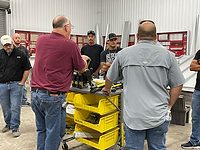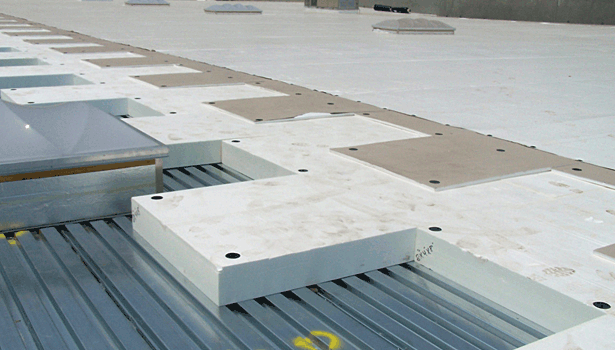Three Projects Show the Benefits of EPS Insulation

A re-roofing project using Foam Control EPS roof insulation added 16.5 R to Walgreens’ existing roof. Photos courtesy of ACH Foam Technologies.


R-values of EPS insulation remain stable for the life of the product.

With SecureTherm EPS insulation, there is no need for a coverboard in membrane applications. Inset: Peters Roofing selected SecureTherm to keep the budget in line for Patterson Dental.






The Walgreens distribution facility in Windsor, Wis., was originally built in 1980 with a standing seam steel roof offering an R-value of 9.5. Owners decided it was time to improve the energy efficiency of the distribution center and hired RRK Associates, Ltd., to carry out the project.
“The original insulation consisted of batt insulation installed on the bottom side of the metal roof panel, totaling approximately 9.5 R,” said Guy Snowden, Principal of RRK Associates, Ltd., the commercial/industrial roof consulting firm on the project. “Walgreens wanted a high-performance roof that would provide better insulative properties and energy savings.”
According to Snowden, the new roof system was selected based on several factors, including:
• Service life and durability.
• Minimal weight gain to existing structure due to low slope of existing roof and anticipated snow loads.
• Ability to add additional high R-value insulation with minimum height gain due to existing curb and penetration heights.
• Cost.
The system chosen included an EPDM membrane from Firestone Building Products over expanded polystyrene (EPS) insulation. “Walgreens’ new roof membrane is a fully adhered, 0.060 mil. Rubbergard EPDM, installed over a base layer of 3-inch Foam Control EPS Roof Insulation formed to the existing metal panel profile with a cover board of Isogard HD insulation. New insulation added 16.5 R to the roof for a total of 26 R,” said Snowden.
According to Tom Huempfner, roofing insulation specialist for ACH Foam Technologies, “Tapered EPS roof insulation is particularly appealing because the installation is faster due to fewer pieces and less cutting. Also, there is less jobsite waste. Polyiso is manufactured in limited thicknesses, therefore when it is installed in a tapered system, multiple layers of polyiso must be used to achieve the same taper thickness as one piece of EPS.”
In all, 1,175,625 board feet of 25psi Type IX Foam-Control® EPS Angle Cut Flute Filler Panels (3 inches by 24 inches by 96 inches), manufactured by ACH Foam Technologies, were used for the project.
“The increase in use of EPS as a roof insulation over the past several years has to do with its cost and installation advantages, combined with its stable and long-term performance. EPS retains its stated R-value over the life of the product, unlike Polyiso, which loses R-value over time due to off-gassing.”
Upon completion of the project this spring, the Walgreens distribution center will sport a new, high-performance roof with an R-value of 26.
Patterson Dental Re-Roofing Project
When Patterson Dental in Dinuba, Calif., upgraded its roof, Peters Roofing, the contractor for the project, also chose EPS insulation. They used SecureTherm™ composite roof insulation and eliminated the need for cover boards in the re-roofing project. SecureTherm™ is a high performance, lightweight and water resistant EPS roof insulation with a factory-applied durable fiberglass facer to meet UL Class A requirements.
Patterson increased their roof insulation specification from R-30 to R-38 to make the building more energy-efficient so that they could receive a rebate from Pacific Gas & Electric. Peters Roofing saved significantly in labor costs by using SecureTherm because the facer is factory applied to the EPS insulation. There is no need for a coverboard in membrane applications.
“We chose SecureTherm because it met the R-38 specification, and brought the project’s budget back on track,” said Jim Nelson of Peters Roofing.
“The two-layer system consisting of 8-inch-thick Type I EPS and a 1 inch thick Type IX SecureTherm cap was mechanically fastened to a metal roof deck beneath a PVC membrane. We installed one layer of EPS insulation followed by SecureTherm, which included the fiberglass facer cover board, rather than having to install two layers of EPS plus a third layer of cover board.”
Yet another EPS product promises lower material and labor costs and reduced environmental impact. Aptly called Direct-to-Deck, it can be applied directly to a steel roof deck without a thermal barrier. According to Frank Kiesecker, V.P. Architectural Products, ACH Foam Technologies has been granted recognition by the International Code Council Service (ICC) for EPS to be applied directly to a steel deck without the requirement of a code specified thermal barrier. This action allows ACH to effectively market product to the roofing industry that is fully codified. (See ICC-ES Evaluation Report ESR-2043.)
“ACH now has the opportunity to provide a cost-effective solution for specifiers and roofing contractors without the added cost of a thermal barrier. We are excited to have fully codified product that offers many benefits over competing products,” said Kiesecker.
Uline Distribution Center
It was EPS Roof insulation to the tune of nearly 3 million board feet that caused eyes to pop during construction of the Uline distribution center, a million-plus square foot facility in Pleasant Prairie, Wis.
Construction of the Uline distribution center was completed in the summer of 2009. Its massive roof required installation of 2.75 million board feet of Foam-Control® EPS insulation, manufactured by ACH Foam Technologies. According to Phil Hunt, Vice President, Materials Management for Uline, material costs — as well as long-term thermal performance and speed of installation — were key factors in choosing EPS insulation for the enormous roof.
“Managing the costs to build, heat and cool a facility like this required a high level of scrutiny during the design and construction phases,” explained Hunt. EPS roof insulation was selected for the project because it provided all of these benefits in addition to meeting the project’s aggressive construction schedule. “After researching the cost and long-term performance of the different types of insulation available, we determined that EPS provided the most thermal protection for the least cost,” Hunt said.
Uline’s large steel framed structure consisted of pre-cast concrete walls and a structurally sloped steel roof deck. The roof design incorporated 245 skylights to provide natural light while reducing electrical costs. One layer of 2.5-inch Type II Foam-Control EPS roof insulation was installed over a steel roof deck in a ballasted EPDM assembly. The membrane manufacturer, Firestone, awarded the project with its full system Red Shield warranty.
“Due to the size, location and fast-tracked schedule of the Uline project, it was imperative that quality materials were delivered in a timely and consistent manner,” explained Chris Busalacchi, Vice President, Schranz Roofing and Sheet Metal. “ACH’s understanding of these requirements and their commitment to fulfill them played a big part in making the project successful. We have worked with the people at ACH Foam for many years and consider them a valuable supplier of roof insulation to our company.”
For more information about ACH Foam Technologies, visit www.achfoam.com.
|
Get Your Project Costs on Track ACH Foam Technologies has a convenient calculator on its website that gives instant comparison costs for various types of insulation with equivalent R-values. It’s available at www.achroof.com. All you need to do is plug in your project square footage and R value; the savings calculator will tell show you side-by-side insulation costs for EPS vs. ISO vs. XPS in flat and tapered applications. |
Looking for a reprint of this article?
From high-res PDFs to custom plaques, order your copy today!










